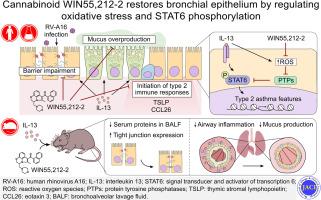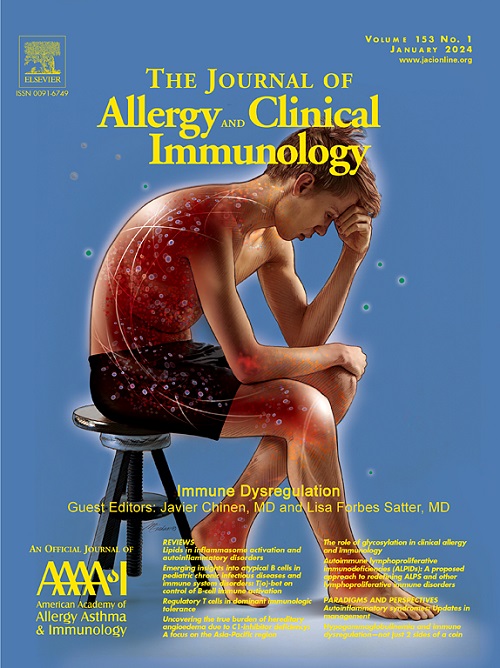Cannabinoid WIN55,212-2 restores bronchial epithelium by regulating oxidative stress and STAT6 phosphorylation
IF 11.2
1区 医学
Q1 ALLERGY
引用次数: 0
Abstract
Background
Viral infections and type 2 immune responses perpetuate airway epithelial barrier dysfunction and inflammation, leading to the development and progression of asthma. The synthetic cannabinoid WIN55,212-2 displays anti-inflammatory properties by acting on different immune system cells.
Objective
We sought to investigate the capacity of WIN55,212-2 to restore bronchial epithelial barrier function in asthma in the context of viral infections or type 2–driven inflammation.
Methods
Air-liquid interface cultures of human bronchial epithelial cells and human bronchial epithelial spheroids were generated to assess the capacity of WIN55,212-2 to restore airway epithelial barrier damage induced by human rhinovirus A16 (RV-A16) infection or type 2 inflammation. RT-PCR, cytokine quantification, permeability assays, metabolic studies, flow cytometry, and Western blot techniques were employed to assess the effects of WIN55,212-2 on the airway epithelium. The in vivo relevance of our findings was evaluated in a murine model of IL-13-induced airway inflammation.
Results
Prophylactic and therapeutic administration of WIN55,212-2 accelerated the recovery from RV-A16-induced bronchial epithelial barrier damage. WIN55,212-2 inhibited the acquisition of IL-13-induced type 2 asthma features in air-liquid interface cultures, self-assembled bronchial epithelial spheroids, and in vivo asthma model of airway inflammation and epithelial dysfunction. Mechanistically, WIN55,212-2 impaired IL-13-induced oxidative stress in epithelial cells, restoring the activity of protein tyrosine phosphatases, which in turn inhibited pSTAT6-mediated signaling pathways and asthma features.
Conclusions
The cannabinoid WIN55,212-2 displays airway epithelial barrier protective effects during RV-A16 infection or type 2 inflammation by mechanisms associated with the modulation of oxidative metabolism and pSTAT6-mediated signaling.

大麻素WIN55,212-2通过调节氧化应激和STAT6磷酸化来恢复支气管上皮。
背景:病毒感染和2型免疫反应使气道上皮屏障功能障碍和炎症持续存在,导致哮喘的发生和发展。合成大麻素WIN55,212-2通过作用于不同的免疫系统细胞显示抗炎特性。目的研究WIN55,212-2在病毒感染或2型炎症的情况下恢复哮喘支气管上皮屏障功能的能力。方法制备人支气管上皮细胞和人支气管上皮球体的气液界面(ALI)培养,评估WIN55,212-2对人鼻病毒A16 (RV-A16)感染或2型炎症引起的气道上皮屏障损伤的修复能力。采用RT-PCR、细胞因子定量、通透性测定、代谢研究、流式细胞术和western blot技术评估WIN55,212-2对气道上皮的影响。我们的研究结果在il -13诱导的气道炎症小鼠模型中进行了体内相关性评估。结果WIN55,212-2预防和治疗均能促进rv - a16诱导的支气管上皮屏障损伤的恢复。WIN55,212-2在ALI培养物、自组装支气管上皮球体和气道炎症和上皮功能障碍的体内哮喘模型中抑制il -13诱导的2型哮喘特征的获得。机制上,WIN55,212-2损伤il -13诱导的上皮细胞氧化应激,恢复蛋白酪氨酸磷酸酶的活性,从而抑制pstat6介导的信号通路和哮喘特征。结论大麻素WIN55,212-2在RV-A16感染或2型炎症中表现出气道上皮屏障保护作用,其机制与氧化代谢和pstat6介导的信号通路的调节有关。
本文章由计算机程序翻译,如有差异,请以英文原文为准。
求助全文
约1分钟内获得全文
求助全文
来源期刊
CiteScore
25.90
自引率
7.70%
发文量
1302
审稿时长
38 days
期刊介绍:
The Journal of Allergy and Clinical Immunology is a prestigious publication that features groundbreaking research in the fields of Allergy, Asthma, and Immunology. This influential journal publishes high-impact research papers that explore various topics, including asthma, food allergy, allergic rhinitis, atopic dermatitis, primary immune deficiencies, occupational and environmental allergy, and other allergic and immunologic diseases. The articles not only report on clinical trials and mechanistic studies but also provide insights into novel therapies, underlying mechanisms, and important discoveries that contribute to our understanding of these diseases. By sharing this valuable information, the journal aims to enhance the diagnosis and management of patients in the future.

 求助内容:
求助内容: 应助结果提醒方式:
应助结果提醒方式:


